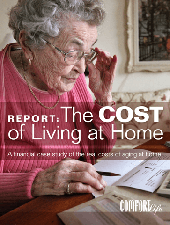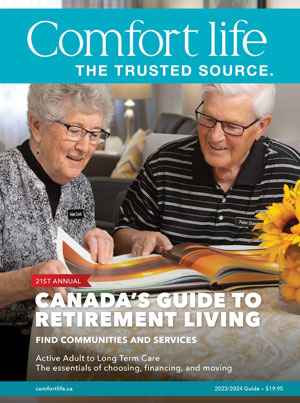Lists of reports on this page:
Find care details, insights, and insider perspectives gained from 20+ years of helping seniors and families.
What to know about this topic:
- Aging in place: the financial picture
- Current living costs while aging at home
- Other articles in this series
Graham, 80, and his wife Ethel, 78, still live in the Willowdale, Toronto, home they purchased new in 1961. Over the years the neighbourhood has changed, and so have they. Graham is likely to fail his driving exam next month due to macular degeneration, and they both have health issues. However, they’re managing fine, and when their out-of-town kids suggest looking into retirement residences, Graham says, “Living at home is free, so why would we move?”
But is aging at home really free?
Aging in place: the financial picture
Graham and Ethel’s income consists of government and private pensions plus Graham’s investments.
| INCOME SOURCE | AMOUNT |
| OAS (Old Age Pension for both Graham and Ethel) | $1,050.00 |
| CPP (Graham only) | $ 960.00 |
| Company pension (Graham only) | $ 850.00 |
| RRIF (Graham’s RRSP that he converted when he was 71) | $ 500.00 |
| TOTAL MONTHLY INCOME | $3,360.00 |
Aging at home checklist
Safety: Many seniors have not updated their homes in years, and usually without regard to safety. A full safety audit should be done from the front door through to the basement, focusing on good lighting; sturdy non-slip floor surfaces; updated and grounded wiring; reliable, energy-efficient appliances; grab bars and handrails; an accessible laundry area; an alarm system for home and/or personal alarm lanyards; and cordless phones. Many of these items can be critical for safely aging at home.
Mobility support: Mobility support is essential for someone like Ethel, whose knee replacements make her fearful of walking. Staying /mobile is vital for errands, exercise and general fitness.
Transportation assistance: Giving up driving is devastating, but transportation is essential for shopping, appointments and social outings. Options include an account with a taxi company, support services like Home Instead, subsidized transit services like the Wheel-Trans in Toronto or volunteer drivers.
Nutrition support: Meals on Wheels has undergone many changes in recent years, and meals can now be purchased to suit a variety of cuisines and dietary requirements. Dinners including soup, hot entrée and dessert can cost as little as $5. It's the choice of many who are aging in place.
Personal care: Personal care refers to bathing, grooming, toileting and dressing. Ethel has difficulty getting into the bathtub and dislikes showers. Graham sometimes let his haircuts lapse, and since laundry is in the basement, clothing may be worn just a few more days before being washed!
They might also investigate other sources of funds or subsidies, such as the Guaranteed Income Supplement (GIS), the Survivor's Pension or a disability allowance to cover Graham’s eye-care costs.
Their home’s value was appraised at $400,000. If they wanted to consider a reverse mortgage to pay for some of the costs incurred by staying in their home, they could get up to 40 per cent of the market value, or $160,000. Assuming five per cent commission and $1,000 closing costs, selling the house could make almost $380,000 available to invest at a conservative three per cent for an annual interest income of $11,400 or $950 per month.
Current living costs while aging at home
Graham and Ethel have only a basic knowledge of what they spend each month, so they were asked to keep a record.
| ITEM | MONTHLY COST |
| Property tax | $275.00 |
| Repairs & maintenance–snow, lawn, repairs | $144.00 |
| Electricity | $125.00 |
| Gas | $130.00 |
| Water | $15.00 |
| Cable TV | $25.00 |
| Phone including long-distance | $55.00 |
| Groceries | $500.00 |
| Drug & department store | $50.00 |
| Liquor | $100.00 |
| Gas for car - 3 fill-ups per month | $120.00 |
| Car expenses | $60.00 |
| Entertainment & gifts | $50.00 |
| Clothing | $50.00 |
| Sundry cash | $400.00 |
| Travel (1trip/year to east coast) | $250.00 |
| TOTAL MONTHLY EXPENSES | $2,349.00 |
These are certainly modest expenses for a couple. Income net of expenses is about $1,000, a comfortable margin, but not if medical costs were to enter the picture.
Now, let’s look at four possible scenarios for Graham and Ethel: aging at home with community support, with agency care, with live-in care, and moving to a local retirement community.
This look at home care vs. retirement living was last updated in 2017 - ed.
Other articles in this series
- Aging at Home with Community Support
- Aging at Home with Agency Care
- Aging at Home with Live-in Care
- Aging in Place vs. Moving into a Retirement Home
We then review the facts about aging in place.
IN-DEPTH REPORTSHome care companies
In-Home Assisted Living Inc.
In-Home Assisted Living offers caregivers and nurses to help seniors and people with medical challenges to remain living in their own home with safety and comfort. Also ask about our hospital bedside support.
Lifestyle Options: Respite care, Assisted Living, Memory Care, Long-term care, Home Care
Take It Easy Care Inc.
Our clients are at the heart of everything we do. We believe in tailoring our services to meet their unique needs, recognizing that no two individuals are the same. Whether it's medical care, companionship, or assistance
Lifestyle Options: Respite care, Assisted Living, Memory Care, Home Care
Richmond Heights Health Clinic and Home Care
Richmond Heights Health Clinic & Home Care, provides compassionate 24 hour personalized senior care services with bonded, registered & licensed Nurses / RPN's, in your home, hospital, rehab, LTC & retirement communities.
Lifestyle Options: Respite care, Assisted Living, Memory Care, Long-term care, Home Care
Nurse For Care
Nurse for All offers medical and non-medical care support for people of all ages & needs in the GTA, Ontario, Alberta, BC, Nova Scotia at home, hospital, retirement home or long-term care facility.
Lifestyle Options: Respite care, Assisted Living, Memory Care, Long-term care, Home Care





